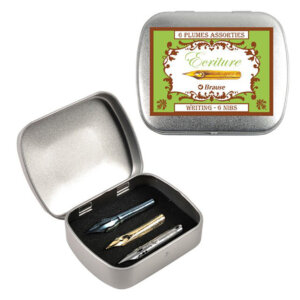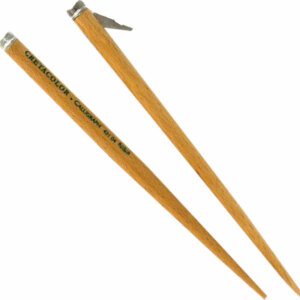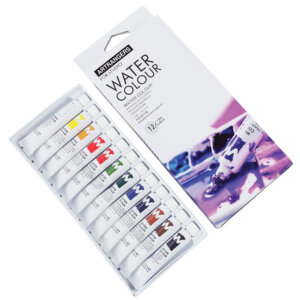Below is a brief guide to other ingredients that you might mix with oil to make your own oil painting mediums based on traditional recipes.
What is the difference between White Spirits, Odourless or Low Toxic Solvents and Turpentine?
Solvents can be divided into two main categories: Those that are extracted from pine trees and those which are petroleum based. Generally it is considered that the solvents that are extracted from pine trees are better suited to using in painting mediums, and in the cleaning of brushes etc., but the quality of these gum-resin based solvents (turpentine) vary hugely, so it is worth considering this when making your decision on which to buy. The quality of these is reflected in the price you pay. Many manufacturers call their high quality turpentine different names, and so if one comes across an English distilled turpentine, or a rectified turpentine, or a gum spirits of turpentine, one is going to be looking at pretty much the same product, and it would all come down to testing each one out to see which one does the job best for you.
Pure turpentine contains more impurities than English Distilled turpentine but is great as a brush cleaner prior to rinsing with soap and lukewarm water. Turpentine is made from the gum resin of pine trees, which is then purified or distilled or rectified to remove the impurities found in the resin, leaving a pleasant, pine smelling, yet effective thinner and cleaner of oil paint. If your turpentine does not smell as good, it could be down to the fact that it may have not been purified to the same extent, or that it may have been made from the mulch and dead pine tree leaves and branches as opposed to a live tree source. Such turpentines will be less stable and although may be cost effective, we would only really recommend these for cleaning brushes and not as an ingredient within an oil paint medium. We strongly recommend using all qualities of varieties of turpentine in a well-ventilated work area, as inhalation of the fumes should be kept to a minimum.
Warning – turpentine may suffer some discolouration if exposed to air over a prolonged period of time, so always worth keeping the lid on tight when not in use.
White Spirit is a paraffin derived, clear transparent liquid, and generally speaking is considered too unstable to be used in oil paint mediums, although can be used as a very effective cleaner for brushes after an oil painting session. However there are special ‘Artist’s White Spirit’ such as the one available from Winsor and Newton, that Winsor and Newton claim is suitable for painting with as part of a medium.
Low odour solvent is another petroleum based thinner, which has had its harmful aromatic solvents removed from its hydrocarbons – while Langridge calls theirs a ‘Low Toxic Solvent’, Winsor and Newton call theirs ‘Sansodor’ (a name derived from the French for ‘without odour’) and it is worth remembering that these are much the same product. The key things to remember with these are that they are less stable than the very finest turpentines, they dry slower when mixed as part of an oil painting medium, and even if they do not emit as strong an aroma into the atmosphere, they still contain harmful fumes that should not be inhaled and so a well-ventilated studio is of paramount importance to the healthy artist’s well-being!
If the artist is concerned about one’s well-being in the studio and would like to find a friendlier solvent to use, then Zest It is our recommendation. Zest It is a solvent, primarily for use by oil painters. It is made from an Aliphatic Hydrocarbon and pure food grade Citrus Oil. It has a neutral pH value and contains no CFC’s or Aromatics and has low VOC’s. It is a clear, colourless liquid which has a pleasant ‘citrus’ smell, is inherently biodegradable and evaporates without leaving any residue. Independent laboratory tests show it has no detrimental effect to the oil paint or pigment quality, proven stability and a long active life. It does not emit any harmful paint fumes and although it is a little more expensive than other solvents, it can be recycled (left to stand so residue sinks to the bottom, and the clear Zest it can be decanted into another vessel to be used again). If you are looking for a solvent with a longer history of use, then Oil of Spike Lavender smells of fresh spring meadows, and has been used by oil painters for hundreds of years. It does emit some fumes but not as many as turpentine, low odour solvent or white spirit might, and it is less potent, and less abrasive than any of those solvents. It has a thicker consistency, and is known to be great for maintaining the quality of brush hairs when used straight as a brush cleaner at the end of a painting session, as well as part of a lustrous, easy-to-use painting medium when mixed with stand oil. It is pricey but a real treat for any serious oil painter.
Larch Venice Turpentine is not for cleaning brushes – it is a thick, thixotropic natural balsam that is extracted from resin (oleoresin) and mixes beautifully with oils (especially walnut or stand oil) and a little distilled turpentine to make a thick, lustrous, glossy, rich oil painting medium that increases the transparency of your colours.
Pure Turpentine
Pure Turpentine is a natural product distilled from pine trees. It can be used in oil painting mediums by mixing with oil (linseed, linseed stand, walnut or safflower etc.). It is also great for cleaning brushes as it is effective yet is not as strong as white spirit and will not dry out the natural moisture of your brush hairs as much. However please note that prolonged exposure of natural hairs to any solvent will accelerate the deterioration of the quality of the hair and cause them to become brittle and break more easily. Turpentine can also be used to thin oil based varnishes, and is superior to white spirit in its ability to blend easily with oils to create even mixtures. To make your own varnish you can simply suspend damar resin crystals wrapped in a lint free cloth into a jar of pure turpentine until the crystals have dissolved. Turpentine’s slow evaporation rate creates a gradual drying time, which again, allows for a more lustrous finish to dried colour that has been mixed with turps.
Warning – turpentine may suffer some discolouration if exposed to air over a prolonged period of time, so always worth keeping the lid on tight when not in use.
Larch Venice Turpentine
Larch Venice Turpentine is a slow drying thixotropic balsam for use in mediums and varnishes. Pure resin from the Austrian Larch tree purified and slightly heated when decanted. Dilute with turpentine or place in warm water bath to obtain fluid consistency.
Langridge Artists White Spirit
- A volatile flammable dilutant for thinning oil colours and cleaning brushes, to be used with care
- Slower drying than turps
- Does not deteriorate on storage
- Less viscous than turpentine
- Evaporates faster (faster drying times) than turpentine
- Is more abrasive than turpentine and will break the oil paint down in a less controllable way
- Gives more watery mixes than turpentine
- Does not have a gum residue like un-distilled decorator’s turpentine, which causes instability and yellowing when used as part of a painting medium
- More refined than decorator’s white spirit, and as a result is more stable when drying and does not leave any tackiness or undesired residue
- Not to be used with professional oil colour
- Similar to Langridge Low Toxic Solvent and Solvent 75
Distilled Turpentine (available by Winsor and Newton & Langridge)
- Fast evaporating, highly refined distillate sourced from the gum of pine trees
- Suitable for removing varnish (damar)
- Keep tightly closed and away from light to prevent oxidation
- Do not use if it has thickened
- Mix with refined or cold pressed Linseed oil, or stand oil, to make a professional painter’s medium. Add siccative to speed drying, and a small quantity of retouching varnish to increase gloss or create a glaze medium
- Winsor and Newton and Langridge triple distil their turpentine to minimise the presence of impurities that compromise stability in the paint layers
- Warning: may suffer some discolouration if exposed to air over a prolonged period of time
Winsor & Newton Sansodor, Gamblin Gamsol & Langridge Low Toxic Solvent and Langridge Solvent 75
- Are all petroleum based mineral spirit solvents that have had harmful aromatic solvents found in its hydrocarbons removed
- Evaporates slowly
- Increases blending time
- Suitable for thinning oil colours and cleaning brushes
- Unsuitable for using with damar rich products, we can provide further specific advice in this.
- Use in a well-ventilated area
- Consider using a great Australian made product from Langridge such as Low Toxic Solvent or Langridge Solvent 75, the latter of which can be sent in the post due to its very safe and low flash point.





